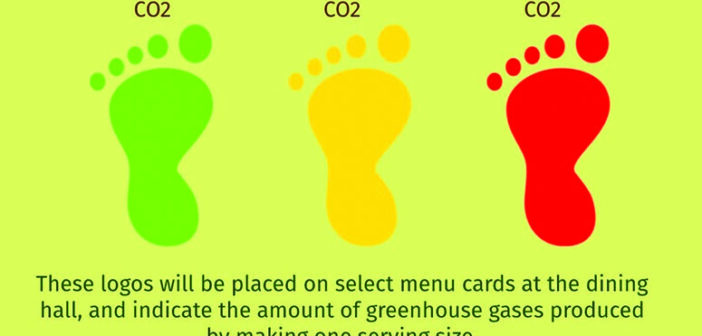When choosing what to eat, there are several factors a student may consider: How does it taste? How much does it cost? How healthy is it? Now, a growing number of students may also be asking: How do my choices at the dining hall impact the environment?
As an attempt to untangle how the food we eat affects the environment, a group of undergraduate students launched the Food Carbon Footprint project, in which they created a database of carbon emission information for the various recipes used by Lehigh’s dining services.
Christine Mosley, ‘22, one of the student leaders for the Food Carbon Footprint project, said the group wanted to make it clear that the purpose of their work is not to tell people what they can or cannot eat.
“What we hope to achieve is for students to think more consciously about their food choices,” she said.
Mosley said one of the biggest problems students face as consumers is figuring out which foods have the lowest or highest impact. Unlike nutritional information, which appears on the labels of most packaged foods, details about the effect on the environment are rarely present.
As stated on the Food Carbon Footprint page, the group created a model that Lehigh’s dining services can implement to give students more information about the impact of their choices, as food makes up a sizable proportion of the campus carbon footprint.
Marc Ferdinandusse, ‘22, is another one of the student leaders for the project. He said the values are in kilograms of carbon per kilogram of product. He said they get those values from various peer-reviewed journals and sources.
“(We put) the recipes from the dining hall into a calculator that uses these values to (give us) the total carbon footprint of the recipe per serving,” Ferdinandusse said.
Mosley said students will see a logo that correlates with the amount of carbon produced from that meal. A green footprint means that the meal has a low carbon impact, whereas a yellow or a red footprint means that the meal has a medium or high one.
Kaya Harper, ‘22, another student leader, said the group encountered a few difficulties.
“Deciding on the messaging was a bit of a challenge,” Harper said. “We really wanted to inspire students to make positive change in their lives (through) the choices they make at the dining hall, (so) the promotional materials try and reflect that message.”
To further promote their message, the group has also been designing initiatives for peer-to-peer education, such as posters that describe how the project works, as well as suggestions for students looking to lower their carbon footprints through a climate-sensitive diet.
Another issue that the group has faced is obstacles related to the uncertainty of the pandemic.
“The pandemic has made it extremely difficult for this project to be implemented into the dining halls because of the lack of in-person dining,” Mosley said. “We want to make an educational impact on our peers, and that is much harder when students need to quickly go into the dining hall to pick up food.”
The group has also started to pivot their focus to measure the long-term impact of their project. It is critical that the group benchmark the carbon footprint of Lehigh’s dining services before their model is implemented, Harper said.
“By asking ourselves, ‘what impact do I personally have on the environment?’ we are one step closer to ensuring a more sustainable way of living for future generations,” Mosley said.






Comment policy
Comments posted to The Brown and White website are reviewed by a moderator before being approved. Incendiary speech or harassing language, including comments targeted at individuals, may be deemed unacceptable and not published. Spam and other soliciting will also be declined.
The Brown and White also reserves the right to not publish entirely anonymous comments.
1 Comment
Perfectly pent content, really enjoyed examining.